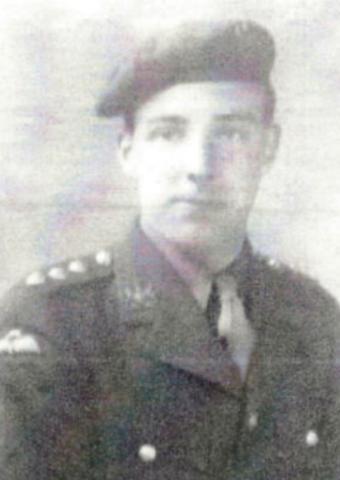Richards was born in Liverpool, the son of Hannah Beatty and George Richards (a World War I veteran and wood machinist). After attending the Wallasey School of Art and Crafts, He later studied at the Royal College of Art for just three months before being conscripted in April 1940 enlisted as a sapper in 286 Field Company, Royal Engineers, 286 Field Company conducted construction and defence works and despite his surrealist leanings (working in a range of media), he frequently painted scenes detailing the variety of these tasks. Several of these works were submitted to the War Artists; Advisory Committee (WAAC), which, impressed with their “freshness and quality”, began acquiring his work from May 1941.
In 1943, Richards volunteered for parachuting duties and completed training at the No.1 Parachute Training School at RAF Ringway, near Manchester. He depicted this training in notable works such as “Kilkenny's Circus” and “Parachute Training over Tatton Park”. He was posted to 591 (Antrim) Para Sqn RE at the end of May In December 1943 he accepted his first six-month WAAC commission, being detached from regular duties.
He was discharged from the RE in March 1944, when granted an honorary General Service commission in the rank of Captain. Later that month Richards took part in a large scale parachute drop over Brize Norton, an event he recalled in the painting “The Drop”. Then, over five days in late April, he took part in the divisional Exercise MUSH, across much of Gloucestershire, Wiltshire and Oxfordshire.
On D-Day itself, Richards landed in France by parachute. He had been attached to the 9th Battalion, the Parachute Regiment and was billeted in their officer’s Mess. In the early hours of the 6 June he observed the attack at the Merville Battery and the subsequent actions on the Breville Ridge. Richards depicted the attack on the battery in several paintings composed within a few days of D-Day including, “The Landing: H Hour Minus 6. In the Distance Glow of the Lancasters Bombing Battery to be Attacked” and “Withdrawing from the Battery After the Battery's Guns Had Been Destroyed. The MO Sets Up His RAP In A Bomb Crater” He also painted memorable scenes such as, the remains of the gliders used in the attack on Pegasus Bridge and others around Ranville and across the 6th Airborne Divisional area.
Richards continued painting, for WAAC, with the advancing Allied forces through France and on into the Low Countries through Autumn and Winter 1944/5. One of Richard's last works, from February 1945, shows a Bailey bridge at Gennep , built by the Sappers across the flooded River Maas. Near that spot, he was sadly killed on 5 March 1945 when his jeep drove over a mine, by sheer mischance. He is buried at Milsbeek CWGC Cemetery, near Gennep.
Albert Richard's, pictures are widely represented in the collections of the Imperial War Museum, The Tate, Walker Art Gallery in Liverpool and the National Maritime
Museum.
Created by Mark Pitt.
Read More

Latest Comments
There are currently no comments for this content.
Add Comment
In order to add comments you must be registered with ParaData.
If you are currently a ParaData member please login.
If you are not currently a ParaData member but wish to get involved please register.